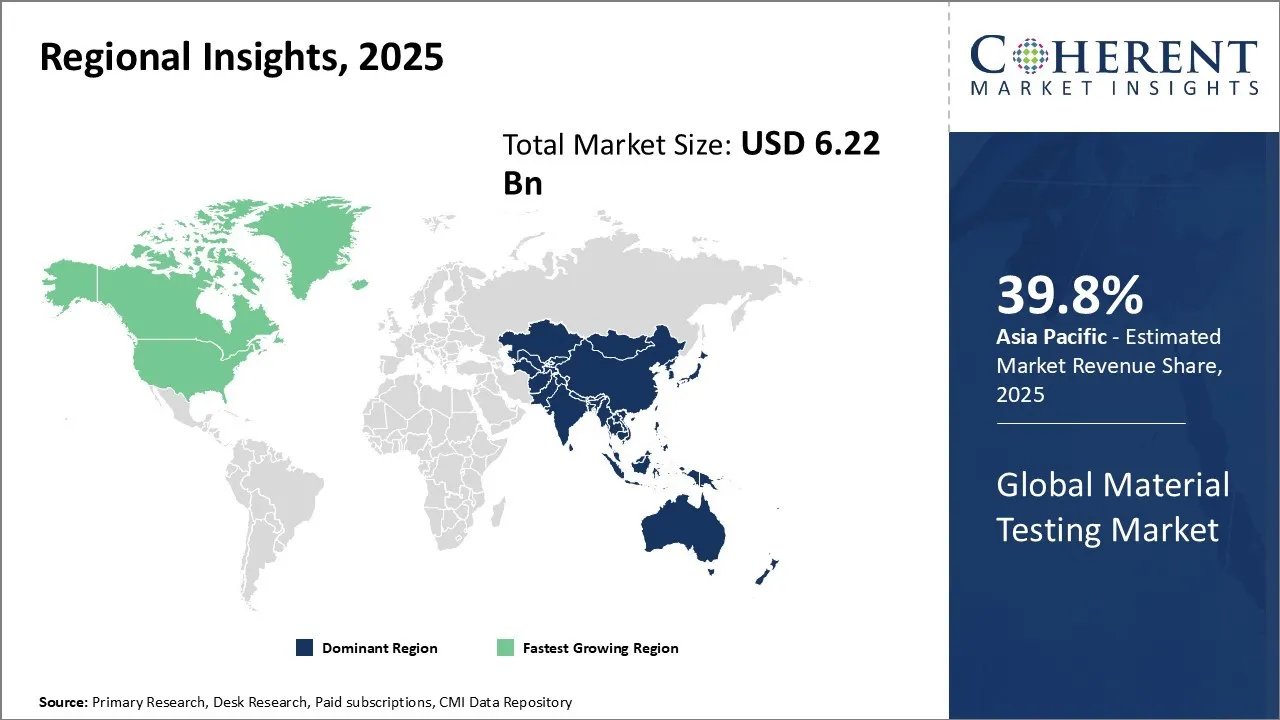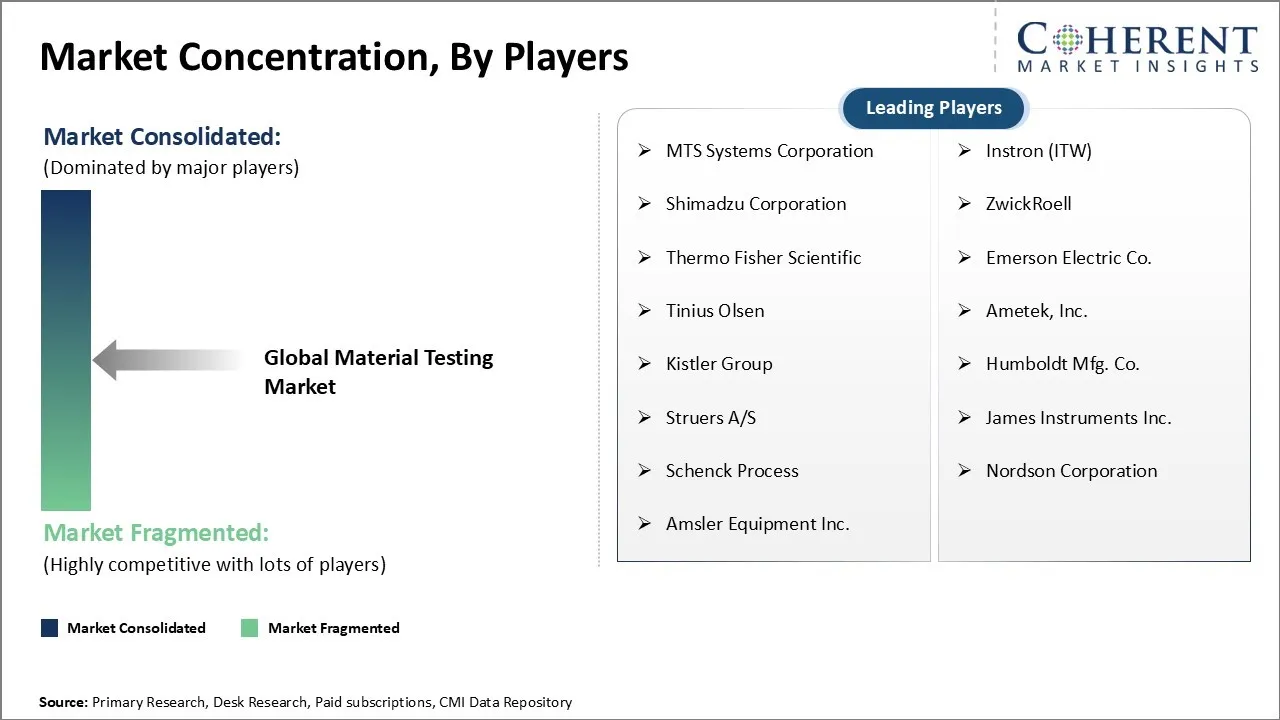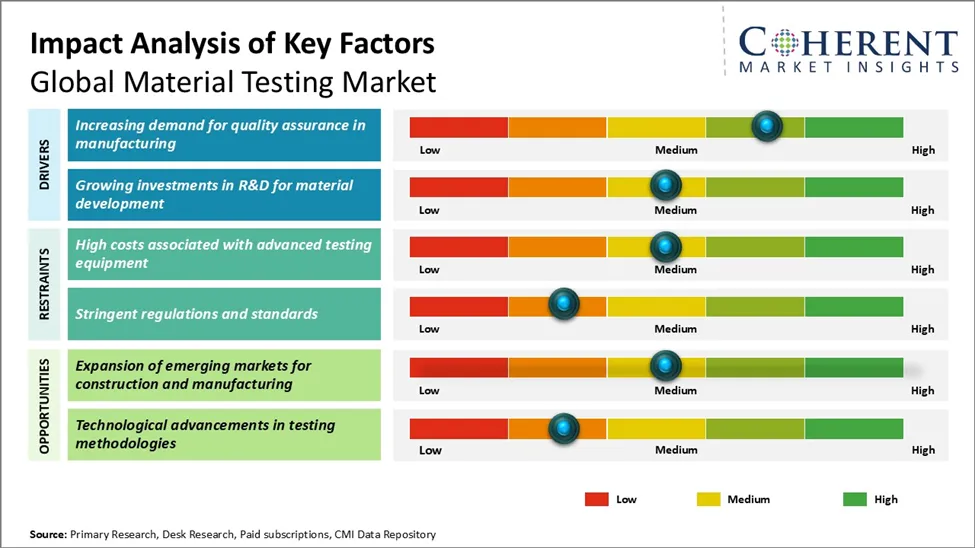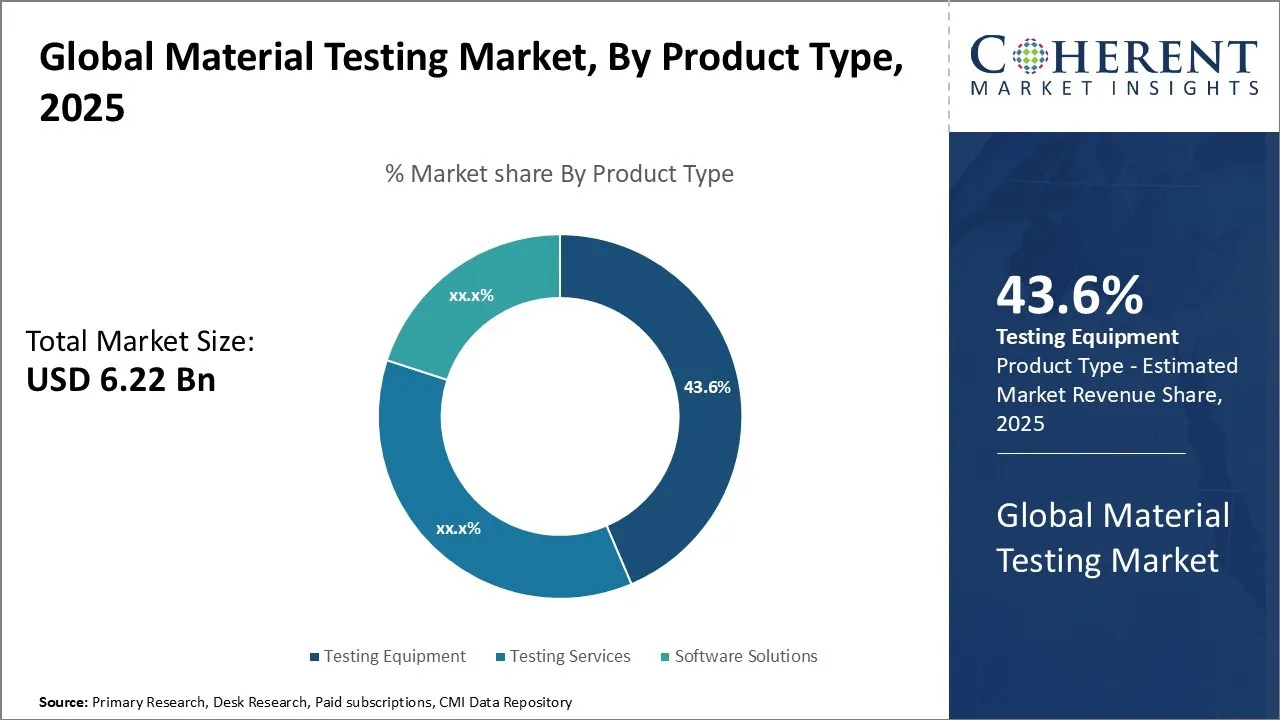Global Material Testing Market Size and Forecast
The Global Material Testing Market is estimated to be valued at USD 6.22 Bn in 2025 and is expected to reach USD 8.86 Bn by 2032, exhibiting a compound annual growth rate (CAGR) of 5.2% from 2025 to 2032.
Key Takeaways of the Material Testing Market
- The testing equipment segment is expected to account for 43. 6% of the market share in 2025, driven by rising innovations and the growing need for accurate material analysis.
- The metals segment is projected to hold a 34. 5% market share in 2025, supported by their widespread applications and the strict performance standards required across various industries.
- The construction segment is expected to capture a 36. 7% market share in 2025, primarily driven by rapid infrastructure development and the tightening of safety regulations worldwide.
- Asia Pacific is expected to lead the global material testing market in 2025 with a 39. 8% share by rapid industrialization, rising investments in infrastructure projects, and increasing adoption of quality assurance practices across manufacturing industries. North America, with a 19.5% share in 2025, will be the fastest-growing region, driven by the growing demand for advanced testing solutions in aerospace, automotive, and construction sectors, as well as stringent regulatory standards requiring precise material performance validation.
Market Overview
A key market trend is the rising adoption of automated and digital material testing solutions, construction material testing equipment, integrating AI and IoT technologies, IoT infrastructure to enhance accuracy and efficiency. Additionally, there is a growing emphasis on sustainable testing practices and the development of eco-friendly materials, which is fostering innovation in testing equipment. The increasing focus on research and development activities, along with expanding infrastructure projects globally, is further propelling market growth and shaping industry dynamics.
Currents Events and their Impact
|
Current Events |
Description and its impact |
|
Technological Advancements in Testing Equipment |
|
|
Growth in Infrastructure and Construction Projects |
|
Uncover macros and micros vetted on 75+ parameters: Get instant access to report
Material Testing Market Insights, By Product Type - Testing Equipment Segment Dominates due to Rising Demand for Material Analysis Across Industries
Testing equipment segment is expected to contribute 43.6% share of the market in 2025 owing to growing innovations and increasing demand for precise material analysis. The dominance of testing equipment within the global material testing market can be attributed to the rising necessity for highly accurate and reliable evaluation of material properties across industries. Testing equipment represents the physical hardware such as universal testing machines, hardness testers, spectrometers, and microscopes that enable material characterization, performance verification, and quality control. A major driving factor behind the growth of this segment is the continual advancement in testing technologies, including automation and digitization, which have revolutionized how materials are analyzed.
Material Testing Market Insights, By Material Type – The Metals segment Leads the Market, Supported by its Wide-ranging Applications and Strict Performance Standards across Various Industries
Metals segment is expected to contribute 34.5% share of the market in 2025, driven by their extensive applications and stringent performance requirements across industries. Metals continue to hold the largest share in the material testing market due to their ubiquitous use across vital sectors such as construction, automotive, aerospace, and manufacturing. The inherent characteristics of metals—such as strength, durability, and resistance to wear—make them essential for structural applications and equipment fabrication. The rigorous testing of metals ensures reliability and safety, especially because failures in metallic components can lead to catastrophic consequences.
One of the key growth drivers in this segment is the growing focus on developing high-performance and specialty metals and alloys, including stainless steel, aluminum alloys, titanium, and superalloys. These materials are engineered to meet exacting standards for mechanical properties, corrosion resistance, and heat tolerance. Material testing for metals involves evaluating tensile strength, hardness, fatigue, and impact resistance, which inform design improvements and regulatory compliance.
Material Testing Market Insights, By End-use Industry – The Construction Segment Holds the Largest Share, Fueled by Rapid Infrastructure Development Activities Worldwide
The construction segment accounts for an estimated 36.7% share of this market in 2025, leading due to accelerating infrastructure development and increasingly stringent global safety regulations. As the largest end user, the construction industry is propelled by widespread urbanization and large-scale infrastructure projects worldwide. A diverse range of construction materials—including concrete, steel, composites, and ceramics—must adhere to rigorous safety and performance standards to guarantee structural soundness and protect public welfare. This imperative for quality assurance and compliance with building codes is a key driver behind the significant adoption of material testing equipment and services within the construction sector.
Regional Insights

To learn more about this report, Download Free Sample
Asia Pacific Material Testing Market Analysis and Trends
The Asia Pacific region is projected to lead the market with a 39.8% share in 2025, primarily due to rapid industrialization, urbanization, and increased infrastructure development in countries like China, India, Japan, and South Korea. Government policies promoting manufacturing and construction sectors, along with ‘Make in India’ and China’s industrial stimulus programs, fuel the demand for high-quality material testing to meet international standards.
Key players, such as Shimadzu Corporation (Japan), Hunan Innov Testing Instrument Co., and ZwickRoell, benefit from growing demand for material testing across the automotive, electronics, and metal industries. Additionally, rising export activities and the need for compliance with global quality norms have made Asia Pacific a hotspot for advanced material testing solutions.
North America Material Testing Market Analysis and Trends
The North America region is expected to exhibit the fastest growth in the market contributing 19.5% share in 2025, driven by a well-established industrial infrastructure, extensive presence of leading testing laboratories, and strong demand across automotive, aerospace, construction, and manufacturing sectors. The region benefits from stringent government regulations and safety standards, particularly by agencies such as the U.S. FDA, OSHA, and ASTM International, which necessitate rigorous material testing protocols.
North America's market ecosystem is robust with well-funded research and development activities and a highly skilled workforce. Notable companies like MTS Systems Corporation, Instron (a division of Illinois Tool Works), and Thermo Fisher Scientific play pivotal roles by providing advanced testing instruments and services, ensuring innovation and reliability in the material testing processes.
Global Material Testing Market Outlook for Key Countries
U.S. Material Testing Market Trends
The U.S. material testing market benefits from a mature industrial base and a strong regulatory framework that ensures compliance with stringent safety and quality standards. The presence of established players like MTS Systems Corporation and Instron provides access to cutting-edge technology for various sectors such as aerospace, automotive, and healthcare. Government initiatives promoting innovation and infrastructure enhancement further stimulate market demand. The country also leads in materials research, contributing to the development of next-generation testing methodologies.
China Material Testing Market Trends
China material testing material testing market is rapidly expanding due to its booming manufacturing and construction industries, along with government emphasis on quality control and product safety. State-supported infrastructure projects boost demand for reliable testing services, while domestic companies like Hunan Innov Testing Instrument Co. are innovating to meet growing needs. Partnerships with international firms enable technology transfer and enhanced testing capabilities. Trade policies focusing on exports necessitate adherence to global standards, driving continuous expansion.
Germany Material Testing Market Trends
Germany continues to lead in material testing within Europe, supported by its strong automotive and machinery manufacturing sectors. The country’s market ecosystem benefits from a network of research institutions, industry associations, and stringent EU regulations on product safety and environmental compliance. Companies such as ZwickRoell and Bruker play critical roles in pushing technological innovation and precision testing. Germany’s focus on quality engineering reinforces its market dominance and serves as a model for other European countries.
India Material Testing Market Trends
India material testing market is driven by rapid infrastructure development, increased industrial activities, and supportive government initiatives like ‘Make in India’ that encourage localized manufacturing and quality enhancement. The growing awareness about product safety and regulatory enforcement is leading to greater adoption of sophisticated material testing equipment. Local firms, along with global players like Shimadzu Corporation and Thermo Fisher Scientific, are expanding their footprint to cater to diverse sectors including automotive, construction, and electronics. Market expansion is also facilitated by government programs aiming to enhance technological capabilities in the testing domain.
Japan Material Testing Market Trends
Japan material testing market leverages its advanced manufacturing industry and technological innovation culture. Leading companies such as Shimadzu Corporation offer highly specialized and precision testing equipment used widely in sectors including semiconductors, automotive, and aerospace. Government policies promoting high safety standards and research funding enhance the market’s breadth. Japan’s export-oriented economy also drives demand for material testing, ensuring compliance with stringent international norms and reinforcing its strong position in the global market.
End User Feedback and Unmet Needs
- Positive Experience Example: Enhanced Data Traceability in Industrial Settings
One frequently cited area of user satisfaction relates to advanced data management and traceability features incorporated into newer generations of universal testing machines (UTMs). For example, a large automotive components manufacturer highlighted how integrating cloud-based data capture and reporting capabilities with their tensile and fatigue testing workflows significantly reduced manual documentation errors and improved compliance with ISO 17025 standards. This streamlined process allowed their quality assurance teams to quickly retrieve historical test records for audits, accelerating time-to-certification by up to 30%. Such capabilities were particularly valued in highly regulated sectors where traceability and documentation integrity are mission-critical.
- Unmet Needs and Market Gaps
Technological Integration Gaps: Many users require seamless interoperability between testing instruments, laboratory information management systems (LIMS), and enterprise resource planning (ERP) platforms. The absence of standardized protocols or flexible APIs creates data silos and manual reconciliation burdens.
- Customization and Modular Scalability
Mid-sized manufacturers and infrastructure agencies often cite the lack of affordable, modular systems that can be scaled incrementally as testing requirements grow. Vendors’ emphasis on high-capacity configurations sometimes leaves smaller buyers underserved.
Market Players, Key Development, and Competitive Intelligence

To learn more about this report, Download Free Sample
Key Developments
- In December 2024, the Federal Government of Nigeria, through the Raw Materials Research and Development Council (RMRDC), unveiled a state-of-the-art X-ray fluorescence Spectrometer aimed at strengthening local capabilities in raw materials testing and analysis. According to a statement by the Council, the equipment—launched by RMRDC’s Director-General, Prof. Nnanyelugo Ike-Muonso—is projected to enhance domestic expertise, create approximately 5,000 jobs, and contribute significantly to government revenue.
Top Strategies Followed by Global Material Testing Market Players
- Established Players: Established market leaders invest heavily in research and development (R&D) to continually innovate and launch high-performance, technologically advanced material testing solutions. This innovation-centric approach helps them address the evolving demands of industries such as aerospace, automotive, construction, and manufacturing, where precision and reliability in material testing are paramount.
- For example, FITCO has developed advanced universal testing machines with integrated Bluehill Universal Software, enabling highly precise data capture and analysis across tensile, compression, and flexural testing applications. This innovation-centric approach helps them address the evolving demands of industries such as aerospace, automotive, construction, and manufacturing, where precision and reliability are paramount.
- Mid-level Players: Mid-level participants in the material testing market adopt a different yet complementary approach by prioritizing cost-effective solutions that strike a balance between quality and affordability. These companies aim to attract price-sensitive customers, such as small and medium-sized enterprises (SMEs) and research institutions, which require dependable testing equipment without the premium pricing of top-tier products.
- For example, Tinius Olsen offers a range of benchtop testing machines tailored for small manufacturers and educational institutions that need dependable equipment without premium pricing. These companies aim to attract price-sensitive customers, such as small and medium-sized enterprises (SMEs) and research institutions.
- Small-scale players: In the global material testing market, these players differentiate themselves through innovation and specialization, targeting niche segments that may be underserved by larger corporations. These companies typically concentrate on developing specialized features or innovative products designed to address very specific testing requirements or new material types.
- For example, Labthink has introduced portable, user-friendly packaging testing instruments specifically designed for barrier property testing in flexible packaging—an area often overlooked by major players. Similarly, Hegewald & Peschke specializes in customized testing machines for wood, plastics, and building materials, catering to clients with unique requirements.
Market Report Scope
Material Testing Market Report Coverage
| Report Coverage | Details | ||
|---|---|---|---|
| Base Year: | 2024 | Market Size in 2025: | USD 6.22 Bn |
| Historical Data for: | 2020 To 2024 | Forecast Period: | 2025 To 2032 |
| Forecast Period 2025 to 2032 CAGR: | 5.2% | 2032 Value Projection: | USD 8.86 Bn |
| Geographies covered: |
|
||
| Segments covered: |
|
||
| Companies covered: |
MTS Systems Corporation, Instron (ITW), Shimadzu Corporation, ZwickRoell, Thermo Fisher Scientific, Emerson Electric Co., Tinius Olsen, Ametek, Inc., Kistler Group, Humboldt Mfg. Co., Struers A/S, James Instruments Inc., Schenck Process, Nordson Corporation, and Amsler Equipment Inc. |
||
| Growth Drivers: |
|
||
| Restraints & Challenges: |
|
||
Uncover macros and micros vetted on 75+ parameters: Get instant access to report
Material Testing Market Dynamics

To learn more about this report, Download Free Sample
Material Testing Market Driver - Increasing Demand for Quality Assurance in Manufacturing
The rising demand for stringent quality assurance in manufacturing is driving the global adoption of advanced material testing technologies. Manufacturers increasingly rely on these methods to validate the properties of materials and ensure compliance with standards, amid stricter regulations and higher consumer expectations. Industries like aerospace and automotive require sophisticated testing for composites and lightweight materials to ensure safety and performance. Reflecting this trend, ISO reported in 2022 an 8% rise in ISO 9001 certifications worldwide between 2020 and 2021, underscoring the growing emphasis on quality control.
Material Testing Market Opportunity - Expansion of Emerging Markets in Construction and Manufacturing
The global material testing market is poised to benefit significantly from the rapid expansion of emerging markets, driven primarily by booming construction and manufacturing sectors. Countries in Asia Pacific, Latin America, and Africa are experiencing accelerated urbanization, industrialization, and infrastructure development, creating an extensive demand for advanced material testing solutions. In these regions, governments are investing heavily in large-scale infrastructure projects such as highways, bridges, residential complexes, and energy plants, necessitating rigorous quality control and compliance with international safety standards.
For instance, according to the World Bank's Global Infrastructure Outlook 2023, emerging economies are projected to account for over 60% of global infrastructure investment through 2030, with particular emphasis on transportation networks, energy facilities, and urban development projects. This surge in construction activity necessitates rigorous testing of concrete, steel, asphalt, and other critical materials, positioning material testing as an indispensable component of the construction value chain. The manufacturing renaissance in these regions, particularly in automotive, aerospace, and electronics sectors, further amplifies the need for advanced material characterization and quality assurance protocols.
Analyst Opinion (Expert Opinion)
- The material testing market is witnessing significant growth, driven by the increasing demand for quality assurance across various industries, including construction, automotive, and aerospace. Companies like Intertek and SGS are leading the charge with innovative testing solutions that enhance material performance and compliance with stringent regulations. Recent conferences, such as the Materials Testing Conference (2023) and the International Conference on Advanced Materials (2022), have underscored the importance of cutting-edge technologies, such as non-destructive testing and AI-driven analytics, in improving testing accuracy and efficiency.
- These events have showcased successful case studies where advanced testing methodologies have not only ensured product safety but also reduced time-to-market for critical applications. As industries increasingly prioritize safety and sustainability, the material testing market is well-positioned for robust growth, driven by innovations that align with evolving regulatory frameworks and consumer expectations for high-quality materials.
Market Segmentation
- Product Type Insights (Revenue, USD Bn, 2020 - 2032)
- Testing Equipment
- Testing Services
- Software Solutions
- Material Type Insights (Revenue, USD Bn, 2020 - 2032)
- Metals
- Polymers
- Composites
- Ceramics
- End-use Industry Insights (Revenue, USD Bn, 2020 - 2032)
- Construction
- Automotive
- Aerospace
- Electronics
- Others
- Regional Insights (Revenue, USD Bn, 2020 - 2032)
- North America
- U.S.
- Canada
- Latin America
- Brazil
- Argentina
- Mexico
- Rest of Latin America
- Europe
- Germany
- U.K.
- Spain
- France
- Italy
- Russia
- Rest of Europe
- Asia Pacific
- China
- India
- Japan
- Australia
- South Korea
- ASEAN
- Rest of Asia Pacific
- Middle East
- GCC Countries
- Israel
- Rest of Middle East
- Africa
- South Africa
- North Africa
- Central Africa
- North America
- Key Players Insights
- MTS Systems Corporation
- Instron (ITW)
- Shimadzu Corporation
- ZwickRoell
- Thermo Fisher Scientific
- Emerson Electric Co.
- Tinius Olsen
- Ametek, Inc.
- Kistler Group
- Humboldt Mfg. Co.
- Struers A/S
- James Instruments Inc.
- Schenck Process
- Nordson Corporation
- Amsler Equipment Inc.
Sources
Primary Research Interviews
- Quality Control Director – Leading Construction Materials Manufacturer
- Chief Materials Engineer – Major Automotive Components Producer
- Procurement Manager – Aerospace Components Supplier
- Head of Testing Laboratory – Third-party Materials Testing Service Provider
Stakeholders
- Manufacturers
- End-use Sectors
- Construction and Infrastructure
- Automotive & Aerospace Components
- Oil & Gas and Energy Equipment
- Electronics and Semiconductors
- Packaging and Plastics
- Regulatory and Certification Bodies
- Testing Laboratories and Certification Agencies
- Equipment Distributors and Integrators
Databases
- ASTM International Standards Database
- Eurostat Trade Database
- UN Comtrade – Import/Export Statistics for Testing Equipment
- India Import Export (EXIM) Database
Magazines
- Quality Magazine – Insights into non-destructive and destructive material testing
- Materials Performance – Updates on corrosion testing, coatings, and materials reliability
- Evaluation Engineering – Testing technologies for manufacturing and aerospace
- Industrial Heating – Material testing in heat treatment and metallurgy
- Advanced Materials & Processes – Trends in material characterization and testing
Journals
- Journal of Materials Research – Advances in testing methodologies
- International Journal of Materials and Structural Integrity – Mechanical testing research
- Materials Testing Journal – Industry-specific testing techniques
- Journal of Testing and Evaluation – Peer-reviewed studies on testing standards
- NDT & E International – Non-destructive testing innovations
Newspapers
- The Wall Street Journal – Market developments in industrial testing equipment
- Financial Times – M&A activity among testing equipment suppliers
- The Guardian – Policy shifts affecting material testing in construction
- Nikkei Asia – Trends in Asia-Pacific testing services and equipment demand
- The Economic Times – India-focused growth in quality assurance markets
Associations
- ASTM International
- International Organization for Standardization (ISO)
- American Society for Nondestructive Testing (ASNT)
- European Committee for Standardization (CEN)
- SAE International – Materials Testing Committees
- American Society for Testing and Materials (ASTM)
- NACE International
Public Domain Sources
- U.S. Department of Commerce – Industry outlook for testing services
- European Commission – Directives and standards for construction and materials testing
- Occupational Safety and Health Administration (OSHA) – Regulations impacting testing protocols
- International Energy Agency – Material testing standards in renewable energy infrastructure
- World Trade Organization (WTO) – Trade data for testing equipment
Proprietary Elements
- CMI Data Analytics Tool, Proprietary CMI Existing Repository of information for last 8 years.
Share
Share
About Author
Yash Doshi is a Senior Management Consultant. He has 12+ years of experience in conducting research and handling consulting projects across verticals in APAC, EMEA, and the Americas.
He brings strong acumen in helping chemical companies navigate complex challenges and identify growth opportunities. He has deep expertise across the chemicals value chain, including commodity, specialty and fine chemicals, plastics and polymers, and petrochemicals. Yash is a sought-after speaker at industry conferences and contributes to various publications on topics related commodity, specialty and fine chemicals, plastics and polymers, and petrochemicals.
Missing comfort of reading report in your local language? Find your preferred language :
Transform your Strategy with Exclusive Trending Reports :
Frequently Asked Questions
EXISTING CLIENTELE
Joining thousands of companies around the world committed to making the Excellent Business Solutions.
View All Our Clients


